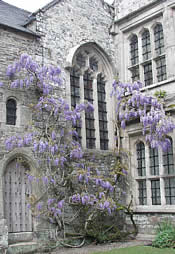
Wisteria seems to enhance every building it accompanies. Perhaps it is at its loveliest upon gray stone walls and lead-paned windows. No one has noted the age of this example, but one can assume it is very, very old.
|
Another recycled post from November, 2018, with a few revisions, which I hope you will enjoy. Haddon Hall near Bakewell in Derbyshire is a fine example of a medieval house which grew into a Tudor estate and has been "virtually unchanged" since the 17th century. Unlike so many country houses, which are remodeled with almost each generation, Haddon has retained it essential early features. Haddon Hall became the property of the Manners family, Dukes of Rutland, by the marriage of Dorothy Vernon (daughter of Sir George Vernon ) to John Manners in 1563. The Manner family home is Belvoir Castle, and like many families with several estates, they tended to stay there, leaving Haddon uninhabited for the most part This was a common pattern, leaving a wife's estate in limbo while entering family activities at the husband's properties. The unintended consequence is the fine condition of some early homes which were inherited by women. Above, my pictures from a recent visit, showing the fine restoration of the rooms carried on by Lord Edward Manners (born 1965), brother of the current 11th Duke of Rutland (born 1959). Cothele sits on the Tamar River, the boundary between Devon and Cornwall. Like Haddon, it is a medieval-cum-Tudor house which retains its early features. The property came into the Edgecumbe family -- who owned it until after World War II -- when Richard Edgecumbe married the heiress Hilaria de Cothele in 1353. The National Trust took over in 1947. Beautiful gardens are terraced down the hillside, essentially a Victorian creation.  Wisteria seems to enhance every building it accompanies. Perhaps it is at its loveliest upon gray stone walls and lead-paned windows. No one has noted the age of this example, but one can assume it is very, very old. The Great Hall at Cothele is similar to the Great Halls in all ancient country houses, the area where the community dined together, played, worked, even slept in the earliest houses. Traditionally the three doors in the screen wall led to the kitchen, the buttery, and the pantry. Among the most admired and unique features of Cothele is the collection of tapestries from the 16th and 17th centuries. Observers have attributed the fine condition o the hangings to "benign neglect" since the family maintained the house while living elsewhere most of the time. Like so many ancient estates, Cothele was an agricultural community and home to dozens of families who occupied the tenant farms and businesses such as the mill (above right) and the shipping center on the river (left).
0 Comments
Leave a Reply. |
Victoria Hinshaw, Author
Archives
July 2024
Categories |
